The Effect of Quenching and Partitioning (Q&P) Heat Treatment on the Microstructure and Mechanical Properties of High Boron Steel
Abstract
1. Introduction
2. Materials and Methods
3. Results and Discussion
3.1. Microstructural Characterization
3.1.1. Microstructure of High Boron Steel in the As-Cast Condition
3.1.2. Microstructure of High Boron Steel after Q&P Heat Treatment
3.2. Distribution and Morphology of Retained Austenite in the High Boron Steel before and after Q&P Heat Treatment
3.3. Effect of Q&P Heat Treatment on Mechanical Properties of High Boron Steel
3.3.1. Hardness and Impact Toughness of the High Boron Steel Treated by Q&P Heat Treatment
3.3.2. Effect of tq on the Wear Property of High Boron Steel
4. Conclusions
- (1)
- The microstructure of as-cast high boron steel is composed of pro-eutectic austenite dendrites and eutectic, which is from the reaction of L→ γ + Fe2B. After solidification, the transformation will occur in the austenite. The borides in eutectic show net-like and rod-like morphology without change in cast cooling and, finally, the matrix is composited of martensite laths and RA.
- (2)
- After being treated by the Q&P process, the borides are partially broken and spheroidized successfully. The matrix is composed of UM and TM and the morphology of RA is mostly changed from blocky to film-like. As the tq in the Q&P process extend from 30 s to 120 s, the volume fraction of RA in the microstructure increases from 4.2% to 19.7% and the distribution becomes more uniform.
- (3)
- Although the macro-hardness of the samples gradually decreases from 61.8 to 55.3 HRC with the extension of tq, the toughness is significantly improved, compared with the as-cast sample, and reaches the maximum (7.5 J·cm−2) when tq is 90 s. In a dry sliding test, the mass loss of treated samples are about 0.06–0.075 g, which shows better wear resistance than that of the as-cast sample (0.084 g) and NM500 (0.124 g).
- (4)
- Mechanical properties improvement is attributable to the change of boride morphology and the improvement of the matrix by increasing the volume fraction of RA. However, as a soft phase in steel, excessive volume fraction of RA will inevitably lead to a decrease in the hardness of the matrix, resulting in deterioration of toughness and wear resistance. From the experimental results of the high boron steel, the volume fraction of RA should be controlled at about 16%.
Author Contributions
Funding
Institutional Review Board Statement
Informed Consent Statement
Data Availability Statement
Acknowledgments
Conflicts of Interest
References
- Lentz, J.; Röttger, A.; Theisen, W. Solidification and Phase Formation of Alloys in the Hypoeutectic Region of the Fe–C–B System. Acta Mater. 2015, 99, 119–129. [Google Scholar] [CrossRef]
- Ma, S.; Xing, J.; Liu, G.; Yi, D.; Fu, H.; Zhang, J.; Li, Y. Effect of Chromium Concentration on Microstructure and Properties of Fe–3.5B alloy. Mater. Sci. Eng. A 2010, 527, 6800–6808. [Google Scholar] [CrossRef]
- Cao, B.; Wang, X.M.; Cui, H.Y.; He, X.L. Non-Equilibrium Segregation of Boron on Grain Boundary in Fe-30%Ni alloy. Int. J. Min. Met. Mater. 2002, 9, 347–351. [Google Scholar]
- Irati, Z.; Nerea, I.; Eric, D.; Volker, S.; Hardy, M.; Pello, U. Toughness Property Control by Nb and Mo Additions in High-Strength Quenched and Tempered Boron Steels. Metals 2021, 11, 95. [Google Scholar] [CrossRef]
- Jahazi, M.; Jonas, J. The Non-Equilibrium Segregation of Boron on Original and Moving Austenite Grain Boundaries. Mater. Sci. Eng. A 2002, 335, 49–61. [Google Scholar] [CrossRef]
- Ozdemir, O.; Usta, M.; Bindal, C.; Ucisik, A. Hard Iron Boride (Fe2B) on 99.97wt% Pure Iron. Vacuum 2006, 80, 1391–1395. [Google Scholar] [CrossRef]
- Berns, H.; Saltykova, A.; Röttger, A.; Heger, D. Wear Protection by Fe-B-C Hard Phases. Steel Res. Int. 2011, 82, 786–794. [Google Scholar] [CrossRef]
- Irati, Z.; Nerea, I.; Eric, D.; Volker, S.; Hardy, M.; Pello, U. Effect of Nb and Mo Additions in the Microstructure/Tensile Property Relationship in High Strength Quenched and Tempered Boron Steels. Metals 2021, 11, 29. [Google Scholar] [CrossRef]
- Ma, S.; Xing, J.; He, Y.; Fu, H.; Li, Y.; Liu, G. Effect of Orientation and Lamellar Spacing of Fe2B on Interfaces and Corrosion Behavior of Fe-B Alloy in Hot-Dip Galvanization. Acta Mater. 2016, 115, 392–402. [Google Scholar] [CrossRef]
- Jian, Y.; Huang, Z.; Xing, J.; Wang, B. Effects of Chromium Addition on Fracture Toughness and Hardness of Oriented Bulk Fe2B Crystals. Mater. Charact. 2015, 110, 138–144. [Google Scholar] [CrossRef]
- Li, M.S.; Fu, X.L.; Xu, W.D.; Zhuang, R.L.; Yu, R.H. Valence Electron Structure of Fe2B Phase and its Eigen-Brittleness. Acta Metall. Sin. 1995, 31, 201–208. [Google Scholar]
- Üçisik, A.; Bindal, C. Fracture Toughness of Boride Formed on Low-Alloy Steels. Surf. Coat. Technol. 1997, 94-95, 561–565. [Google Scholar] [CrossRef]
- Sen, U.; Sen, S.; Koksal, S.; Yilmaz, F. Fracture Toughness of Borides Formed on Boronized Ductile Iron. Mater. Des. 2005, 26, 175–179. [Google Scholar] [CrossRef]
- Li, K.; Huang, Z.; Jian, Y.; Min, T.; Lou, X.; Wang, S. Friction and Wear Behavior of Single-Phase Fe2B Bulk under Dry Sliding Condition. Tribol. Trans. 2017, 61, 513–521. [Google Scholar] [CrossRef]
- Yi, D.; Xing, J.; Zhang, Z.; Fu, H.; Yang, C. Effect of Titanium and Nitrogen Additions on the Microstructures and Three-Body Abrasive Wear Behaviors of Fe–B Cast Alloys. Tribol. Lett. 2014, 54, 107–117. [Google Scholar] [CrossRef]
- Yi, D.; Zhang, Z.; Fu, H.; Yang, C.; Ma, S.; Li, Y. A Study on the Microstructures and Toughness of Fe-B Cast Alloy Containing Rare Earth. J. Mater. Eng. Perform. 2014, 24, 626–634. [Google Scholar] [CrossRef]
- Liu, Z.-L.; Chen, X.; Li, Y.-X.; Hu, K.-H. High Boron Iron-Based Alloy and its Modification. J. Iron Steel Res. Int. 2009, 16, 37–42. [Google Scholar] [CrossRef]
- Mohrbacher, H. Property Optimization in As-Quenched Martensitic Steel by Molybdenum and Niobium Alloying. Metals 2018, 8, 234. [Google Scholar] [CrossRef]
- Mohrbacher, H. Synergies of Niobium and Boron Microalloying in Molybdenum Based Bainitic and Martensitic Steel. Fundam. Appl. Mo Nb Alloy. High Perform. Steels. 2014, 1, 83–108. [Google Scholar]
- Larrañaga-Otegui, A.; Pereda, B.; Jorge-Badiola, D.; Gutiérrez, I. Austenite Static Recrystallization Kinetics in Microalloyed B Steels. Met. Mater. Trans. A 2016, 47, 3150–3164. [Google Scholar] [CrossRef]
- Hulka, K.; Kern, A.; Schriever, U. Application of Niobium in Quenched and Tempered High-Strength Steels. Mater. Sci. Forum 2005, 2005, 519–526. [Google Scholar] [CrossRef]
- Sharma, M.; Ortlepp, I.; Bleck, W. Boron in Heat-Treatable Steels: A Review. Steel Res. Int. 2019, 90, 1900133. [Google Scholar] [CrossRef]
- Ma, Q.; Liu, B.C.; Wang, Z.C. Breakup of Eutectic Carbide Network of White Cast Irons at High Temperatures. Mater. Sci. 1995, 30, 3383–3386. [Google Scholar]
- Wang, S.; Jiang, Q.; Cui, X.; He, Z. Influence of Trace Elements and Heat Treatment on Carbide Morphology and Properties of CD-2 Steel. Mater. Sci. Eng. A 1999, 264, 172–176. [Google Scholar] [CrossRef]
- Speer, J.; Matlock, D.; De Cooman, B.; Schroth, J. Carbon Partitioning into Austenite after Martensite Transformation. Acta Mater. 2003, 51, 2611–2622. [Google Scholar] [CrossRef]
- Varshney, A.; Sangal, S.; Kundu, S.; Mondal, K. Super Strong and Highly Ductile Low Alloy Multiphase Steels Consisting of Bainite, Ferrite and Retained Austenite. Mater. Des. 2016, 95, 75–88. [Google Scholar] [CrossRef]
- De Moor, E.; Matlock, D.K.; Speer, J.G.; Merwin, M.J. Austenite Stabilization through Manganese Enrichment. Scr. Mater. 2011, 64, 185–188. [Google Scholar] [CrossRef]
- Koistinen, D.; Marburger, R. A General Equation Prescribing the Extent of the Austenite-Martensite Transformation in Pure Iron-Carbon Alloys and Plain Carbon Steels. Acta Met. 1959, 7, 59–60. [Google Scholar] [CrossRef]
- Shi, X.-L.; Jiang, Y.-H.; Zhou, R. Effects of Rare Earth, Titanium, and Magnesium Additions on Microstructures and Properties of High-boron Medium-carbon Alloy. J. Iron Steel Res. Int. 2016, 23, 1226–1233. [Google Scholar] [CrossRef]
- Speer, J.G.; Assunção, F.C.R.; Matlock, D.K.; Edmonds, D.V. The “Quenching and Partitioning” Process: Background and Recent Progress. Mater. Res. 2005, 8, 417–423. [Google Scholar] [CrossRef]
- De Moor, E.; Lacroix, S.; Clarke, A.; Penning, J.; Speer, J. Effect of Retained Austenite Stabilized via Quench and Partitioning on the Strain Hardening of Martensitic Steels. Met. Mater. Trans. A 2008, 39, 2586–2595. [Google Scholar] [CrossRef]
- Xiong, X.; Chen, B.; Huang, M.; Wang, J.; Wang, L. The Effect of Morphology on the Stability of Retained Austenite in a Quenched and Partitioned Steel. Scr. Mater. 2013, 68, 321–324. [Google Scholar] [CrossRef]
- Ding, R.; Tang, D.; Zhao, A. A Novel Design to Enhance the Amount of Retained Austenite and Mechanical Properties in Low-Alloyed Steel. Scr. Mater. 2014, 88, 21–24. [Google Scholar] [CrossRef]
- Xiao, B.; Xing, J.; Ding, S.; Su, W. Stability, Electronic and Mechanical Properties of Fe2B. Phys. B Condens. Matter 2008, 403, 1723–1730. [Google Scholar] [CrossRef]
- Huang, Z.; Xing, J.; Guo, C. Improving Fracture Toughness and Hardness of Fe2B in High Boron White Cast Iron by Chromium Addition. Mater. Des. 2010, 31, 3084–3089. [Google Scholar] [CrossRef]
- Jian, Y.; Huang, Z.; Xing, J.; Sun, L.; Gao, Y.; Zheng, Q. Investigations on the Mechanical Properties and Three-Body Wear Behavior of Pure Fe2B Intermetallic with Different Chromium Additions. Wear 2019, 418–419, 273–280. [Google Scholar] [CrossRef]
- Berkowski, L.; Borowski, J.; Rybak, Z. The Influence of Structure on the Results of the Nitriding of Ledeburitic Chromium Steels. Part VI. Ion Nitriding of NC11LV Steel Burnishing after Hardening on Martensitic Structure. Obróbka Plast. Met. 2009, 20, 3–14. (In Polish) [Google Scholar]
- Drozd, K.; Walczak, M.; Szala, M.; Gancarzyk, K. Tribological Behavior of AlCrSiN-Coated Tool Steel K340 Versus Popular Tool Steel Grades. Materials 2020, 13, 4985. [Google Scholar] [CrossRef] [PubMed]
- Yan, H.; Zhao, L.; Chen, Z.; Hu, X.; Yan, Z. Investigation of the Surface Properties and Wear Properties of AISI H11 Steel Treated by Auxiliary Heating Plasma Nitriding. Coatings 2020, 10, 528. [Google Scholar] [CrossRef]
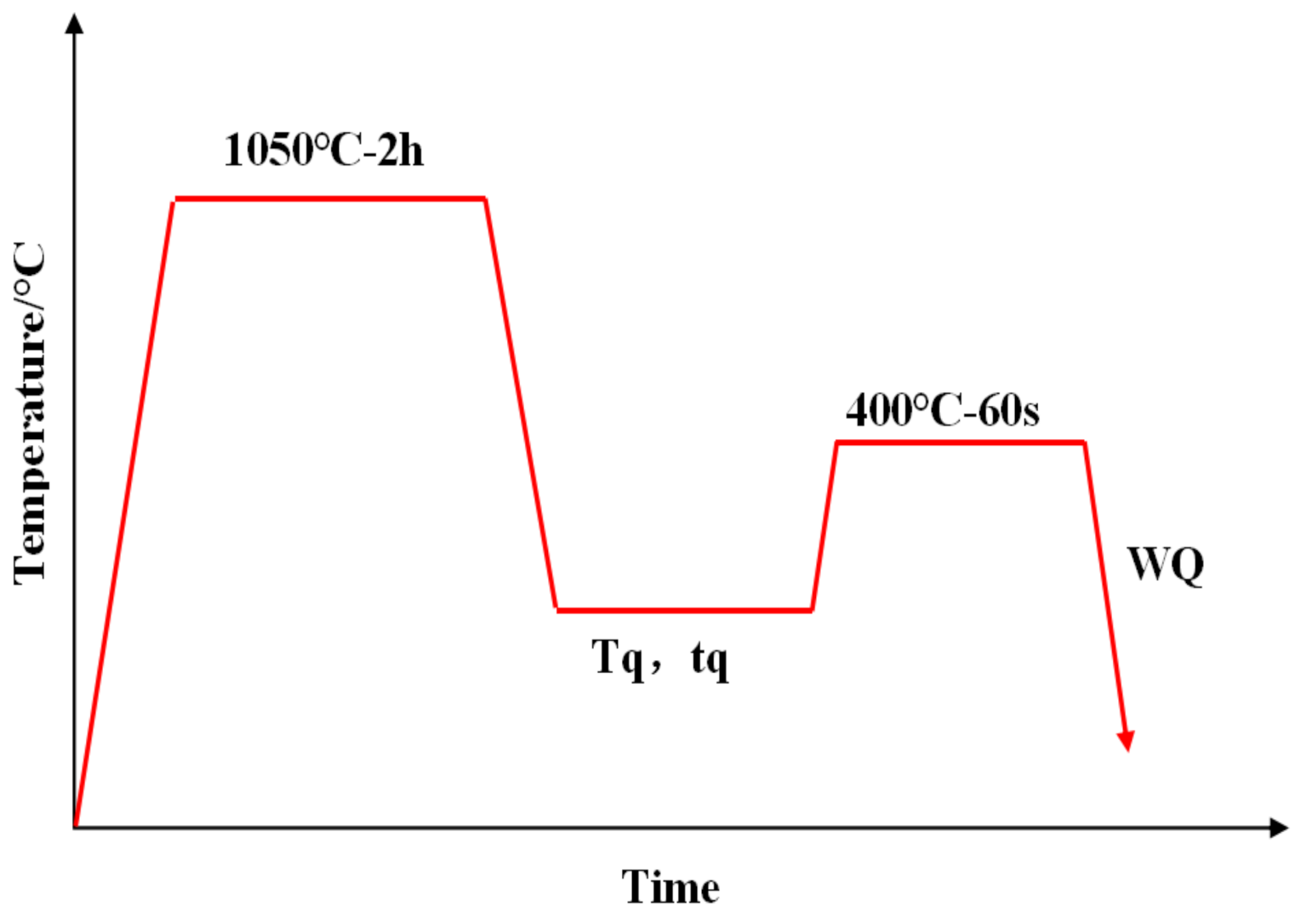

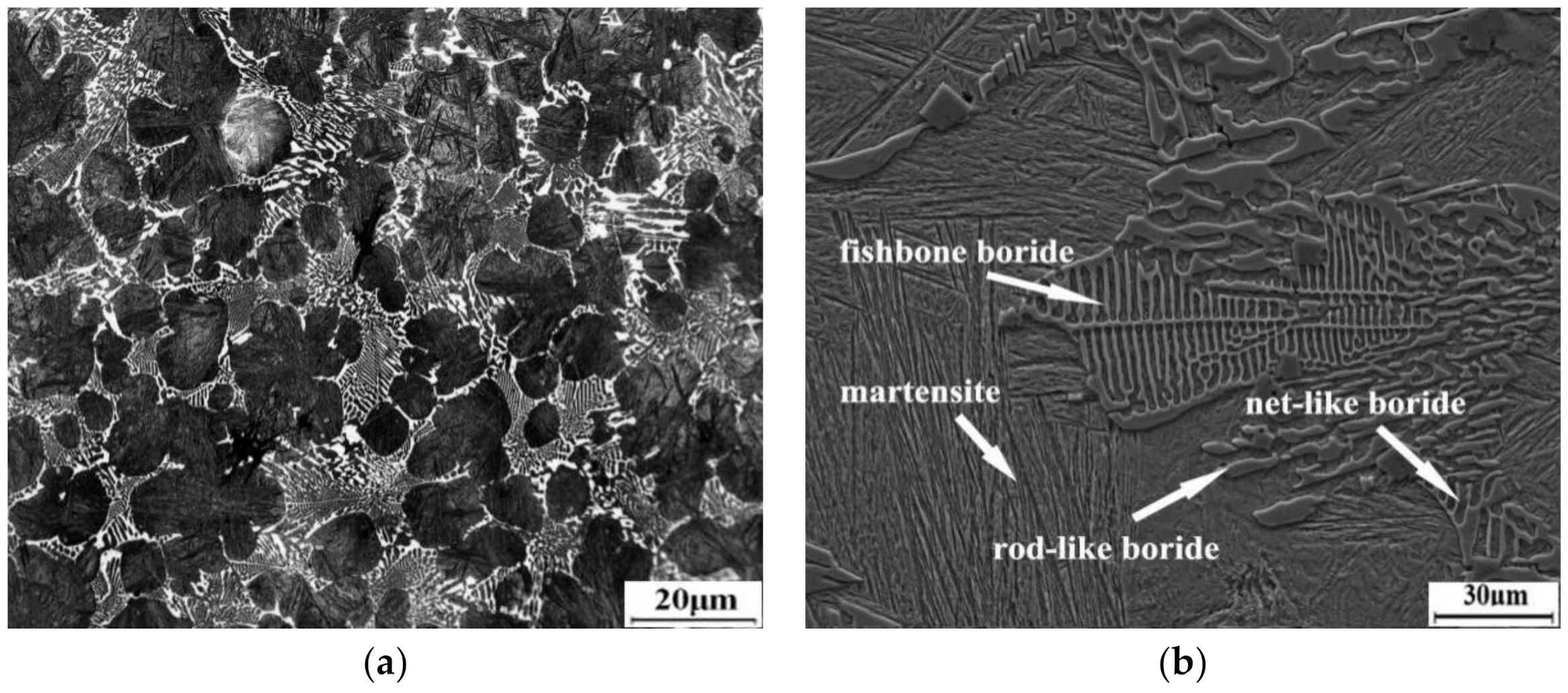
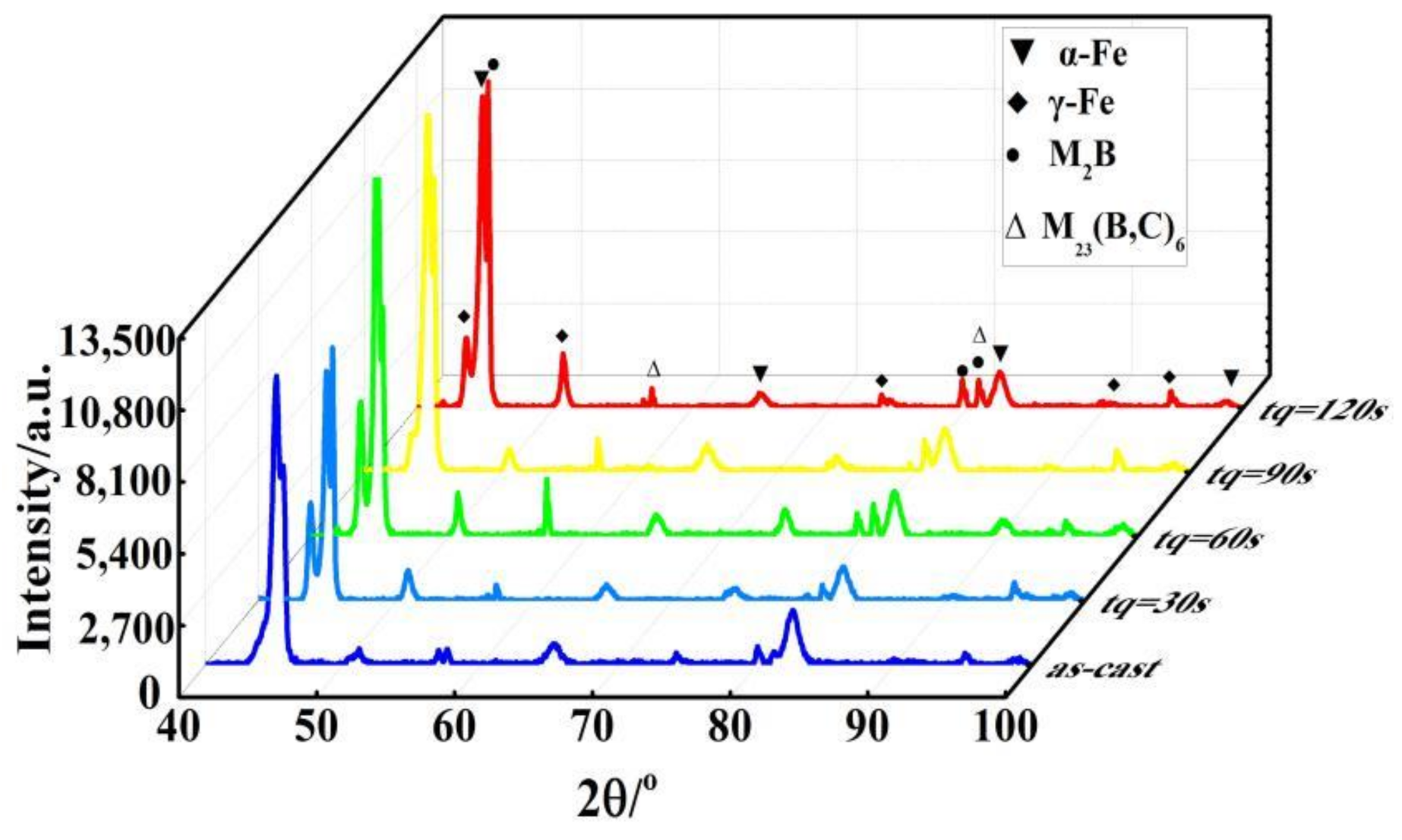
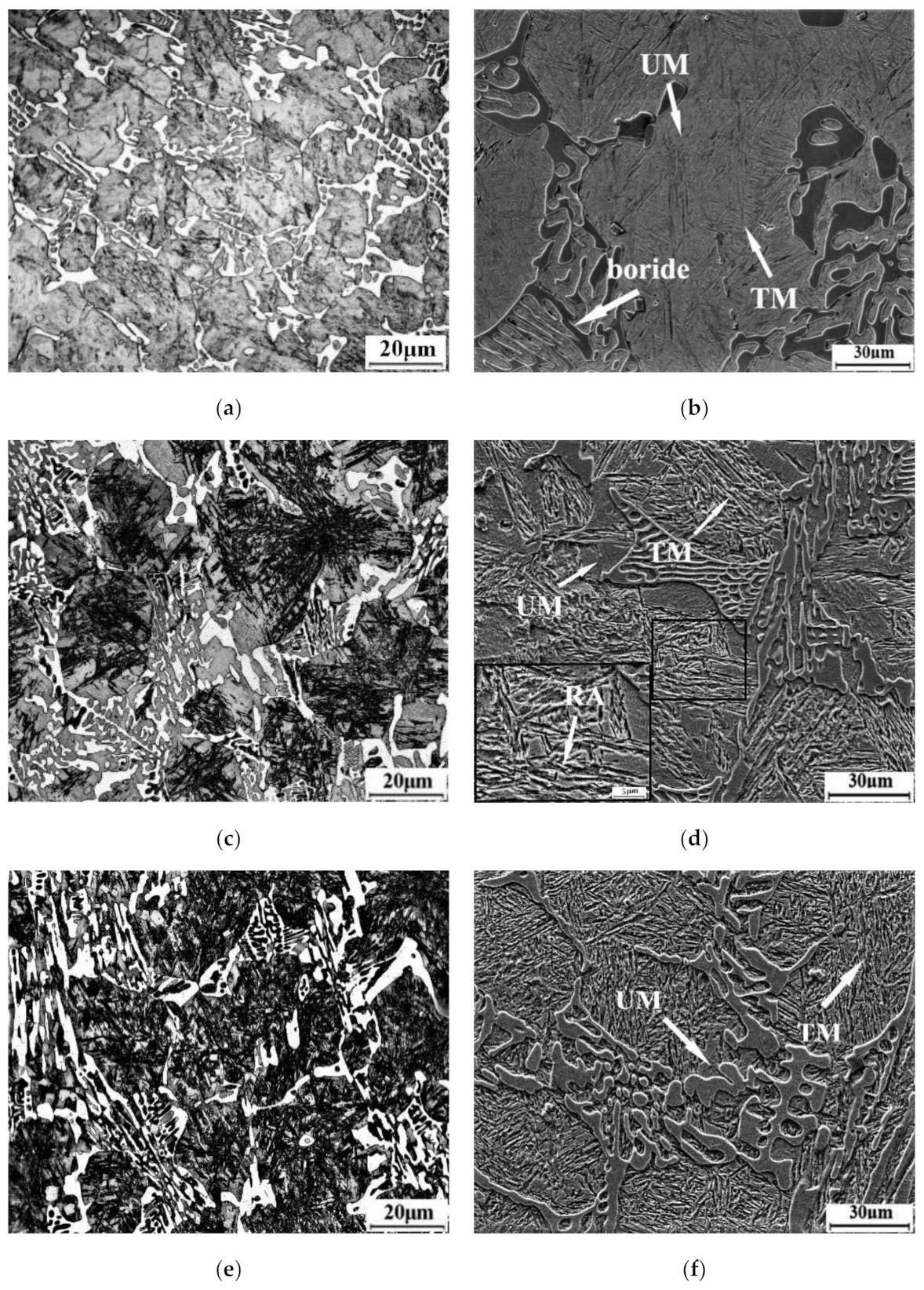
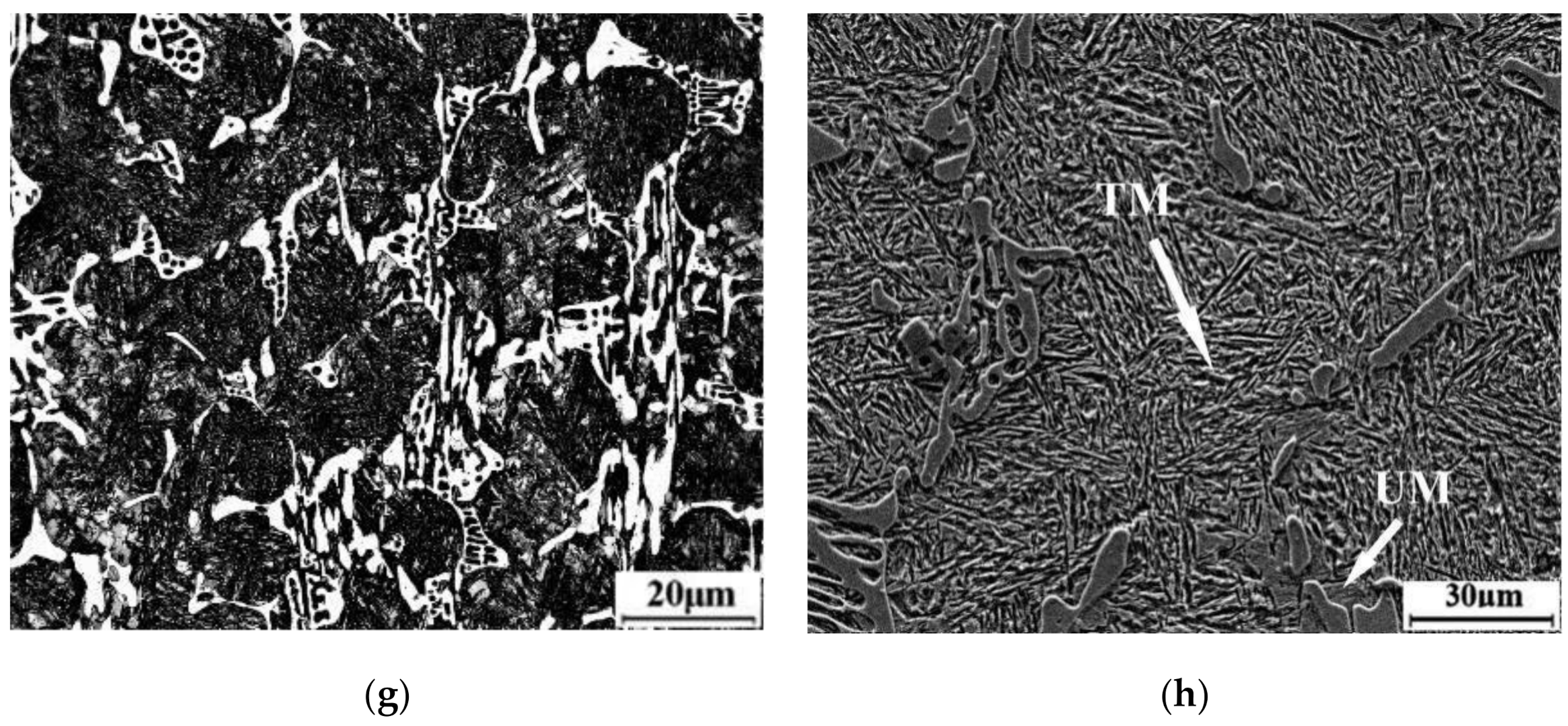
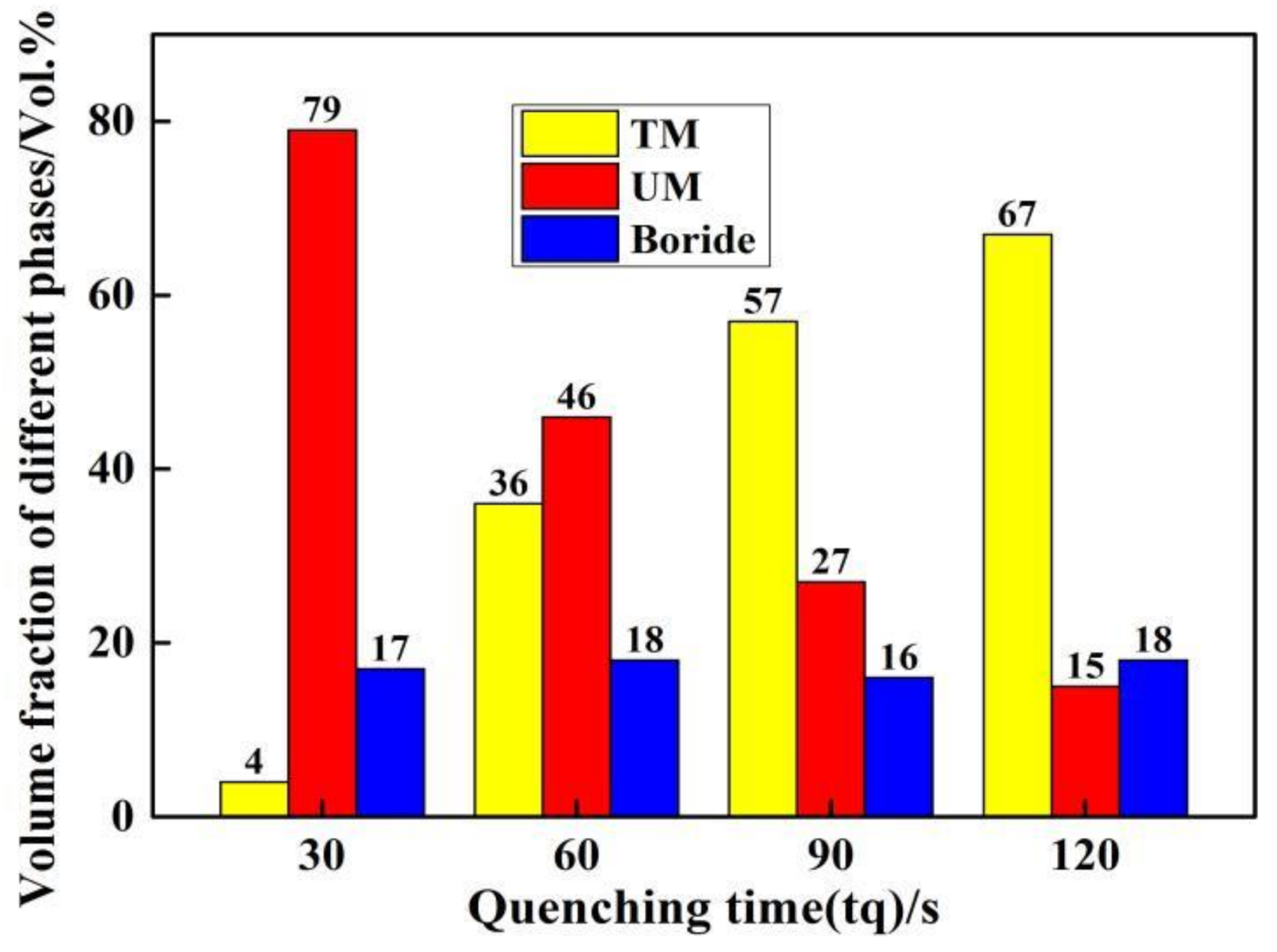

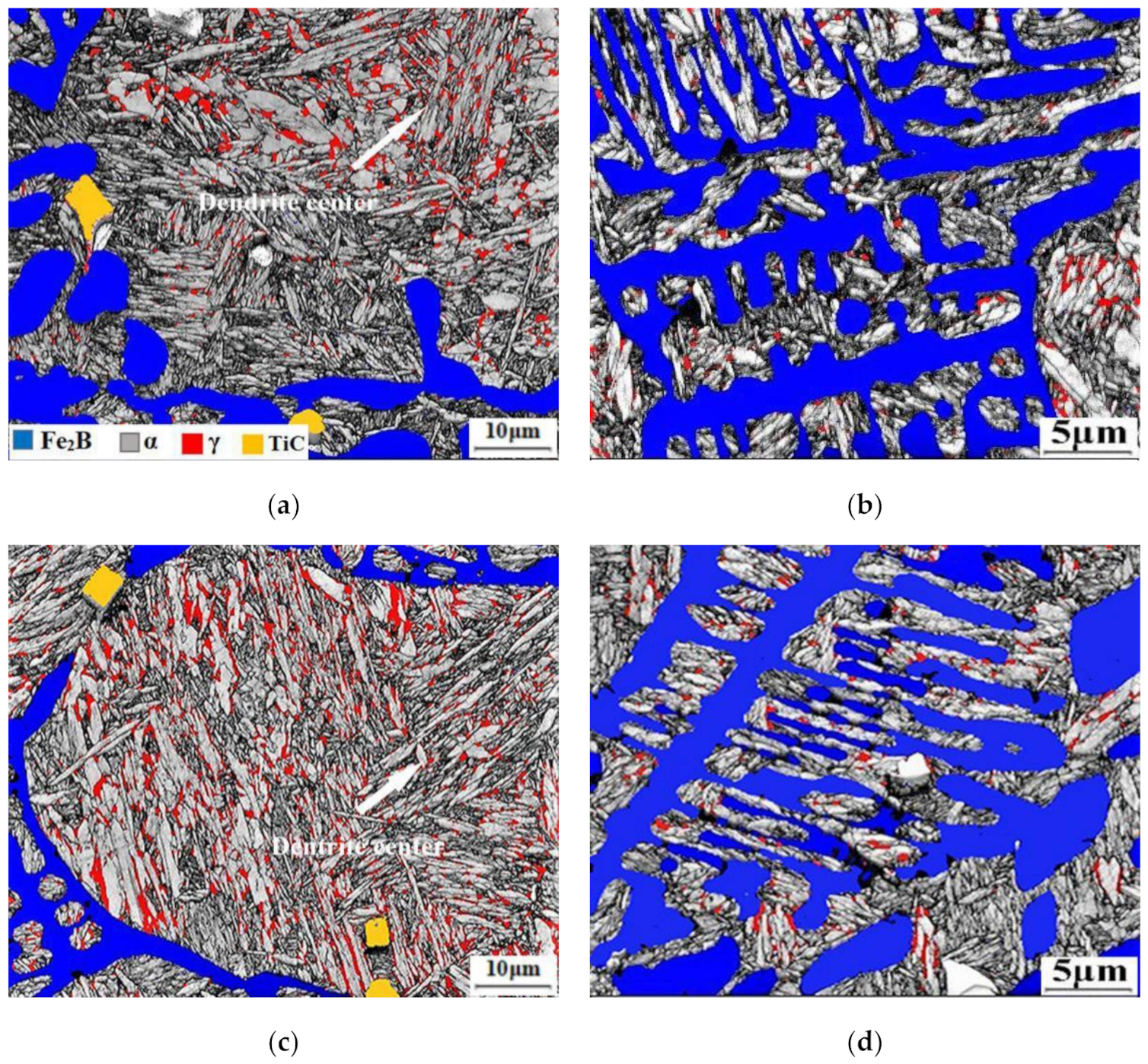


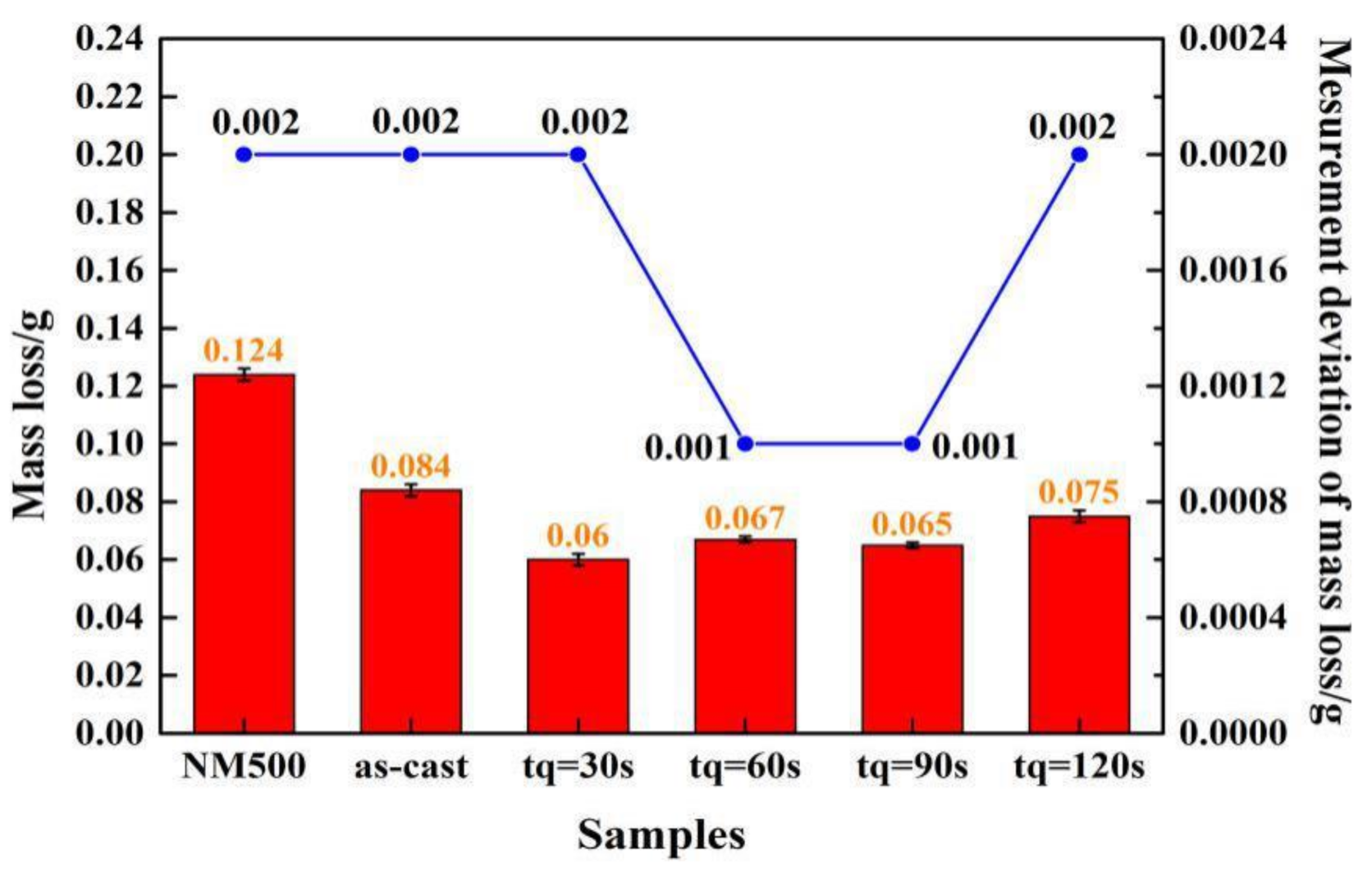
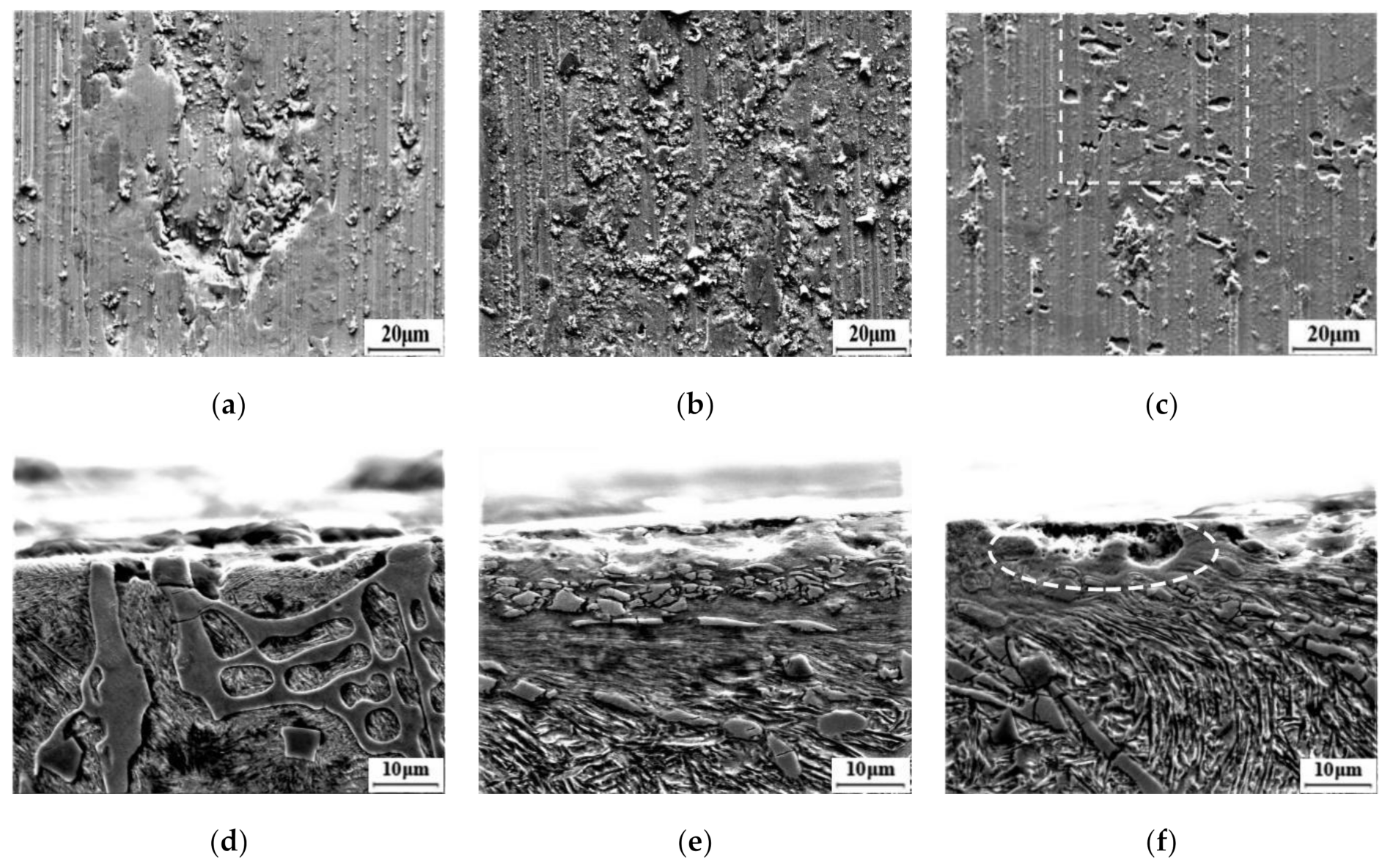
| C | B | Mn | Al | Si | Ti | Nb | V | S | P |
|---|---|---|---|---|---|---|---|---|---|
| 0.45 | 1.6 | 4.0 | 0.8 | 1.0 | 0.3 | 0.03 | 0.05 | <0.06 | <0.06 |
| tq/s | Hardness/HRC | Impact Toughness/J·cm−2 |
|---|---|---|
| 30 | 61.8 | 4.4 |
| 60 | 58.0 | 5.6 |
| 90 | 56.1 | 7.5 |
| 120 | 55.3 | 6.3 |
Publisher’s Note: MDPI stays neutral with regard to jurisdictional claims in published maps and institutional affiliations. |
© 2021 by the authors. Licensee MDPI, Basel, Switzerland. This article is an open access article distributed under the terms and conditions of the Creative Commons Attribution (CC BY) license (http://creativecommons.org/licenses/by/4.0/).
Share and Cite
Li, Z.; Wu, R.; Li, M.; Zeng, S.-S.; Wang, Y.; Xie, T.; Wu, T. The Effect of Quenching and Partitioning (Q&P) Heat Treatment on the Microstructure and Mechanical Properties of High Boron Steel. Materials 2021, 14, 1556. https://doi.org/10.3390/ma14061556
Li Z, Wu R, Li M, Zeng S-S, Wang Y, Xie T, Wu T. The Effect of Quenching and Partitioning (Q&P) Heat Treatment on the Microstructure and Mechanical Properties of High Boron Steel. Materials. 2021; 14(6):1556. https://doi.org/10.3390/ma14061556
Chicago/Turabian StyleLi, Zhao, Run Wu, Mingwei Li, Song-Sheng Zeng, Yu Wang, Tian Xie, and Teng Wu. 2021. "The Effect of Quenching and Partitioning (Q&P) Heat Treatment on the Microstructure and Mechanical Properties of High Boron Steel" Materials 14, no. 6: 1556. https://doi.org/10.3390/ma14061556
APA StyleLi, Z., Wu, R., Li, M., Zeng, S.-S., Wang, Y., Xie, T., & Wu, T. (2021). The Effect of Quenching and Partitioning (Q&P) Heat Treatment on the Microstructure and Mechanical Properties of High Boron Steel. Materials, 14(6), 1556. https://doi.org/10.3390/ma14061556






